Decarbonization and a Recycling-based Society
Construction of a Recycling-based Society
- “Recycling-based” and “low-carbon” business models
- 3R activities (Reduce, Reuse, Recycle)
- Promotion of green purchasing
“Recycling-based” and “low-carbon” business models
Initiatives for a recycling-based society
SECOM’s security services not only provide “safety and peace of mind” to society but also prevent the loss of assets due to theft and fire and limit the consumption of resources from rebuilding. It can be said that the security business itself contributes widely to environmental conservation.
For overseas general security services, customers purchase security equipment themselves, arrange installation work, and are responsible for maintenance. The security company performs only unusual monitoring work, and the police respond when an abnormality occurs.
On the other hand, SECOM’s on-line security systems take full responsibility for the entire life cycle of the equipment from the development and manufacture of the security equipment to installation, operation, collection, and disposal within Group companies. In our R&D and equipment manufacturing, we implement “environment-friendly design” that aims to eliminate hazardous substances, save power and resources, have a long service life, and be recyclable. Furthermore, since the security equipment used by customers is based on a rental system, installed security equipment is collected, repairable items are repaired and reused, and waste disposal is handled appropriately. As a result, we can proactively reduce waste, effectively use resources, and reduce greenhouse gases that cause global warming.
In this way, SECOM’s on-line security systems are “recycling-based” and “low-carbon” business models that can continuously improve the recycling rate, energy efficiency, and resource utilization efficiency.
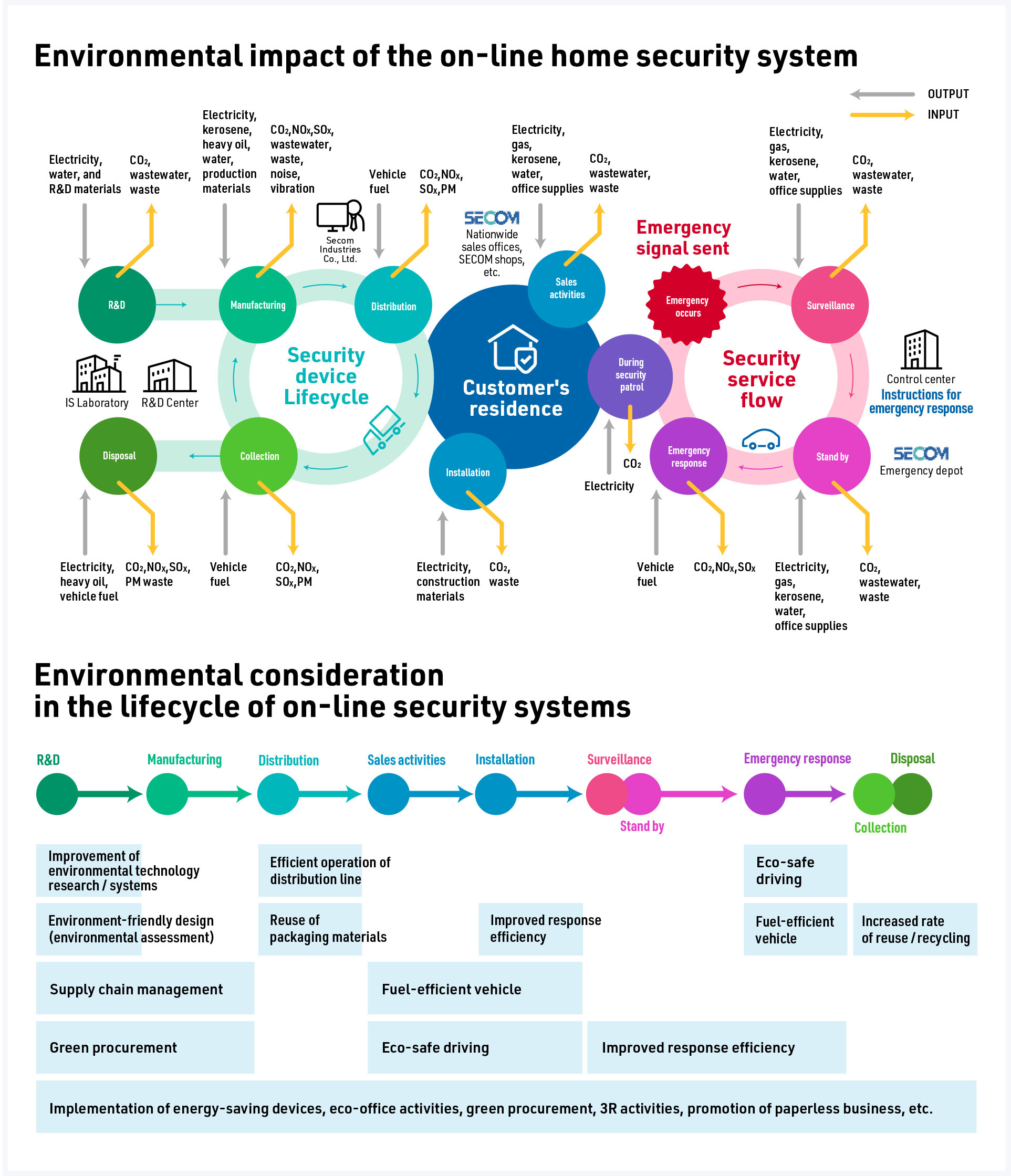
Promotion of environment-friendly design
The R&D Center (Technology Development Division), which is in charge of development and design for security equipment and products, practices “environment-friendly design” in consideration of environmental impact. Specific design issues include energy conservation, efficient utilization of resources, long-term usage, exclusion of hazardous chemicals, and weight-reduction/space-saving measures for packaging materials.
Furthermore, we distribute green engineering guidelines to major suppliers, to seek cooperation for business activities that take the global environment into consideration, and work to protect the global environment throughout the entire value chain. In July 2018, the third edition of the guidelines was released, with revision to more specific requirements, adding four types of hazardous chemicals.
3R activities (Reduce, Reuse, Recycle)
From the viewpoint of environmental conservation and effective use of resources, security equipment collected from customers is thoroughly inspected and separated into equipment to be reused and equipment to be discarded. In addition, the housing and electronic boards of discarded equipment are thoroughly separated into plastic and metal.
Lead-acid, nickel metal hydride, lithium, and other batteries that are built into our security devices are separated and recycled by type.

Examples of our initiatives to reduce usage of plastics
Example 1: Improved our packaging for “SECOM Senior Care Phone Service 2” to reduce plastic usage
By using cardboard boxes with interlocking tabs and placing paper-based cushioning material on top, we reduced the amount of plastic cushioning and tape that we previously used.
Example 2: Environmentally friendly promotional items
We switched the ballpoint pens we give away as promotional items to those made with recycled resin, including plastic waste that flowed into the ocean (marine plastic).
Example 3: Replacing plastic folders with paper folders
We changed the clear folders used for storage from plastic to paper.
Example 4: Adoption of kraft tape
We changed the packaging tape used for some products from plastic to paper.
Example 5: Adoption of biomass-derived plastic bags
We switched the bags used for shipping security equipment collected from customers to our logistics centers to biomass-derived plastic bags.
Initiatives at logistics centers and recycling in cooperation with business partners
SECOM operates logistics centers in Miyagi, Kanagawa and Fukuoka prefectures, where we manage security equipment inventories and have shipping systems that allow us to provide a stable nationwide supply of products daily. We also separate security equipment collected from customers into reusable equipment and equipment to be recycled by business partners. Performing this process at our logistics centers improves the recycling rate when the equipment is handed over to our business partners. Equipment that cannot be reused is passed on to our business partners, where it is disassembled and crushed into individual materials for material recycling and thermal recycling. This approach ensures that SECOM’s security equipment is recycled through different methods.
We will continue to promote the adoption of a circular economy with an eye towards realizing a recycling-based society.

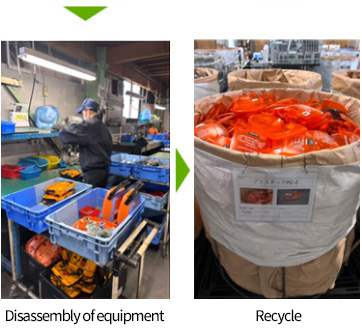
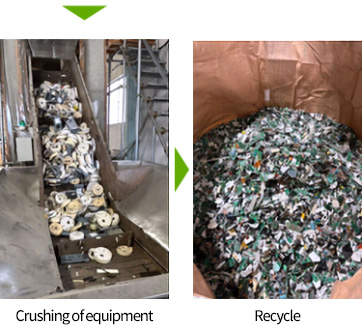
Conversion of waste plastic including uniforms to RPF
In the fiscal year ended March 31, 2020, we shifted the disposal of waste plastic, including AED carry cases, to RPF (solid fuel) processing. This initiative has led to reduced CO2 emissions from incineration and significantly decreased the final disposal volume.
In the fiscal year ended March 31, 2021, we also redesigned the uniforms for our on-site security personnel, including emergency response, armored car services, static guard, and control center staff. The uniforms now use stretchy, quick-drying, and breathable materials, and are made with environmentally friendly plant-based polyester (a 30% blend), which helps reduce the CO2 emissions throughout their life cycle.
RPF (refuse-derived paper and plastics-densified fuel) is a solid fuel made primarily from waste paper that is difficult to recycle as paper material and waste plastic. Replacing coal with RPF not only helps prevent global warming but also contributes to reducing and stabilizing production costs.
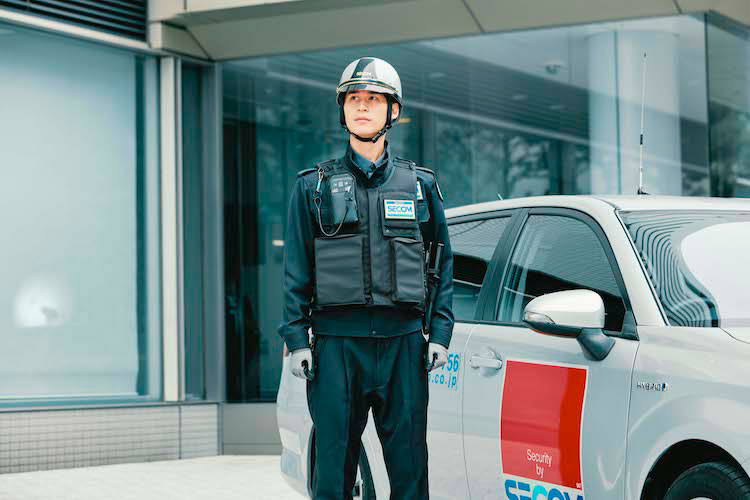
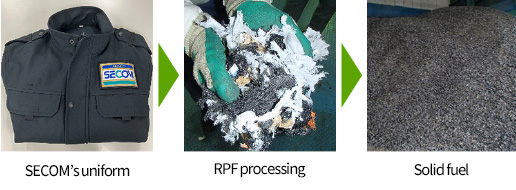
Promotion of green purchasing
At SECOM, we prioritize the use of green products* with a low environmental impact for consumables such as office supplies and printer paper used in our daily operations. We base our approach on the criteria of the Law on Promotion of Procurement of Eco-Conscious Goods and Services by the State and Other Entities (Green Purchasing Law).
In our office supplies ordering system on the company intranet, green products are given priority when a user selects products. Use of this ordering system ensures that the ratio of green purchasing has increased and we have achieved improved efficiency of ordering operations and reduction of unit purchase price.
* Green products: Products that fall under “Eco Mark Certified Products,” “Green Purchasing Law Compliant Products,” or “GPN (Green Purchasing Network) Registered Products.”






